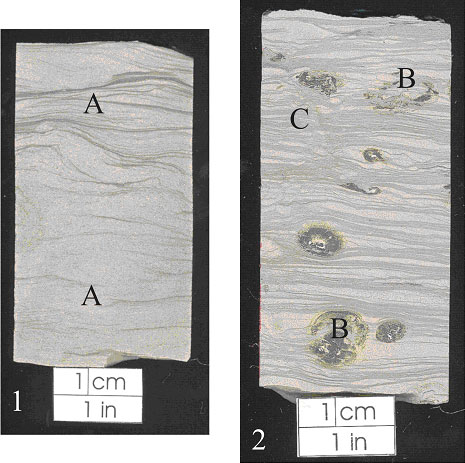 |
|
Kansas Geological Survey Open-file Report 2003-82 |
2.1.4 Interlaminated Sandstone and Siltstone Facies
Description
The interlaminated sandstone and siltstone lithofacies consists of light gray
to brown medium- to fine-grained sand laminae intercalated with medium gray
silt to mud laminae (3-10 mm; Figure 2.06). Diagnostic features include soft
sediment deformation, clay ironstone nodules that are 0.5 inches in diameter
(12 mm), mud laminations (3-10 mm) and scattered rip-up clasts that are 0.25
inches in diameter (6 mm), and wave ripples. The facies displays numerous
fining upward packages (1-5 cm; approx. 24 packages) over approximately 3
feet (1 m). The upper portion of the facies is commonly massive, fine-grained
sandstone with minor mud drapes, while the lower portion is medium- to fine-grained
sandstone with abundant intercalated mud and silt laminae. Individual sand
laminae have unidirectional ripples, while mud drapes have a bimodal orientation.
Wavy, flaser and lenticular bedding are also common. A low diversity trace
fossil assemblage is dominated by actively filled horizontal (cf. Paleophycus),
and passively filled vertical burrows (cf. Skolithos). No body fossils were
observed. The interlaminated sandstone and siltstone facies ranges in thickness
from 10 to 30 feet (3 to 9 m). The lower contact with underlying facies is
typically erosional, while the upper contact with overlying facies is gradational.
Paleoenvironmental Interpretation
The presence of mud drapes dipping in opposite directions and numerous fining
upward packages indicates sediment fallout during slack-water intervals from
tidal influence (Buatois et al., 1999). The low trace fossil diversity indicates
a stressed brackish-water marginal marine or deltaic environment. Erosional
basal contacts, unidirectional flow alternating with bimodal flow, and upward
fining packages suggest channel-fill deposition that may be tidally influenced.
This facies is interpreted as a marginal marine environment. Historically,
in the cyclothem model, the interlaminated sandstone and siltstone facies
would be interpreted as part of the “outside shale” (Heckel, 1977).
 |
| Figure 2.06 - Polished core section showing of the interlaminated sandstone and siltstone facies . 1) Rippled fine-grained sandstone laminae with minor mud drapes. Individual sandstone laminae are characterized by unidirectional cross-stratification (A). Cross-stratification orientations among sandstone laminae are bi-directional. 2) Medium- to fine-grained sandstone and interclated mudstone to siltstone laminae with soft sediment deformation, clay ironstone (B), vertical burrows (C). Sample 1 from 904' and sample 2 from 899' in the Hinthorn CW#1 well, 14-T32S-R16E, Montgomery County, Kansas |
e-mail : webadmin@kgs.ku.edu
Last updated December 2003
http://www.kgs.ku.edu/PRS/publication/2003/ofr2003-82/chapter2_4.html